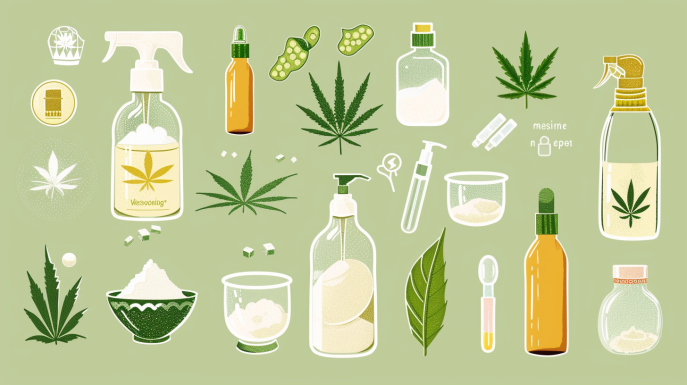As a cannabis consumer, you obviously want only the best for your health. Sadly, there are instances where weed is contaminated with various adulterants to boost the dealer’s profit. In this article, we’ll show you how to detect Brix, hairspray, and sugar in your buds and the health risks these adulterants pose. The subject of “Cannabis Adulterants” is of great importance to every consumer, so read on and learn how to safeguard yourself.
A Quick Summary on Adulterants in Weed for Those Who Prefer a Fast Read:
Adulterants in weed can be harmful to your health. To detect Brix, hairspray, and sugar in your cannabis buds, pay attention to color, smell, taste, texture, and burning behavior. Unnatural colors, chemical smells, sticky or oily textures, and unusual burning behavior may indicate adulterants. Also observe the ash texture and smell when burned. By recognizing adulterants, you can protect your health and ensure that you are consuming only pure weed.
Why Adulterants in Weed are So Dangerous
Adulterants in weed are not merely annoying but can also pose health risks. Some of these substances are less harmful than others, but all have their negative impacts. Here are some of the most known and dangerous adulterants and their risks:
- Brix: Causes breathing problems similar to bronchitis
- Bird and quartz sand: Long-term consumption can damage the lungs
- Talcum: Can lead to silicosis, a lung disease common among miners
- Sugar: Caramelized sugar residues stick to lung tissue, causing cough and sore throat
- Hairspray: Irritates the respiratory tract and can release carcinogenic substances
- Glass: Micro cuts in the lung and potential lung failure with long-term consumption
- Lead: Highly hazardous and can lead to life-threatening lead poisoning
- Phosphorus and potassium fertilizer PK13/14: Can cause headaches and potential thyroid problems
- Mold: Causes respiratory irritation, cough, and sore throat
How Burning Behaviour Can Indicate Adulterated Cannabis
Ever wondered if the burning behaviour of your weed is a little off? It’s quite a revealing way to detect possible adulterants. So, if you’re suspecting that your stash might have been tampered with, here’s what to look out for when it comes to its burning behaviour:
- Smouldering Weed: Pure, unadulterated cannabis should only burn for a few seconds once you light it up. However, if you notice your weed smouldering and smoking unusually long, it could mean that it’s been adulterated with substances like sugar water or Brix.
- Burning Odour: Adulterated cannabis often gives off atypical smells when burnt. For instance, weed laced with sugar water usually smells like caramel, while hair spray-treated weed has a distinct chemical odour.
- Taste When Touched by the Tongue: If you suspect your weed might be laced with sugar water, give it a little taste test. If it tastes sweet when touched by the tongue, that’s another sign of sugar adulteration.
- Ash Consistency: The consistency of the ash can also provide helpful clues. While the ash of pure cannabis should be light grey and fine, adulterated weed often produces darker, sticky or oily ash. For instance, Brix-treated weed results in greasy and oily ash, while hair spray-laced weed produces black and firm ash.
- Changed Flame Colour: Some adulterants can even change the colour of the flame when burnt. If you see a bluish or greenish flame when lighting up your weed, it could be a sign of chemical adulterants.

To use burning behaviour as an indicator of adulterants in cannabis, it’s key to familiarise yourself with how pure weed behaves. The better you can differentiate between normal and suspicious burning behaviour, the easier it’ll be to identify adulterated weed and take appropriate action.
How to Spot Brix in Your Weed
Brix is a synthetic adulterant primarily made up of sugar, hormones, and liquid plastic. It’s either sprayed onto dried cannabis flowers or the flowers are dipped into it, all with the intention of increasing weight and thus, the seller’s profit. Weed treated with Brix appears fresh, moist and the buds seem to have been tightly compressed. Burning Brix-laced weed results in poor combustion and leaves behind a hard, dark ash. You can also detect Brix by its sourish-to-bitter taste and smell.
Identifying Hair Spray in Your Weed
Hair spray is commonly used to make cannabis buds appear shinier and stickier. The resin glands or trichomes on the buds seem abnormally glossy. When you rub such a bud between your fingers, you’ll notice a pungent, chemical smell that’s reminiscent of solvents or hair spray. The burning process gives off an unpleasant, piercing smell and the smoke could cause a burning sensation in your lungs. Another sign of hair spray in your weed is black, sticky ash that’s difficult to get rid of.
Spotting Sugar in Your Herb
At times, sugar is utilized as an extender to make the buds heavier and stickier. Buds infused with sugar often carry an unusually shiny, sticky surface, giving off an impression of being high on THC. When ignited, the sugar can caramelize and emanate a distinct sweet, burnt smell. This could lead to coughing and a scratchy sensation in your throat. The ash from sugar-laced weed is usually dark and sticky and doesn’t come off easily.
Reading tip: Interested in learning how to determine the quality of your cannabis buds on your own? Our piece “How to Recognize Good Cannabis” dishes out all the crucial information and tips you need to differentiate top-notch quality from subpar cannabis. Learn more and become a cannabis quality connoisseur!
More Tips for Identifying Extenders in Your Weed
Apart from the methods mentioned above, here are some additional pointers that can assist you in identifying extenders in your weed:
- Check out the appearance: Healthy weed should be green and resinous, devoid of any unnatural shine or lumps. Extenders can alter the look of weed, making it seem unnatural.
- Take a whiff: Pure weed has a characteristic earthy smell, which can have different undertones depending on the strain. Extenders can tamper with the smell, giving it a chemical or artificial scent.
- Feel the texture: The texture of weed should be soft and easily crumble, without being overly sticky or hard. Extenders can modify the texture, making it seem unnatural.
- Burn a small amount: Watch the flame and ash formed when burning. Pure weed should leave behind a white or light grey ash, whereas extenders often produce a dark, sticky, or clumped ash.
- Trust your gut: If something about your weed feels “off”, you should listen to your intuition and refrain from consuming it.
How to Protect Yourself from Extenders in Weed
The best way to ensure your weed is free from extenders is by acquiring it from trusted sources. Here are some tips to safeguard yourself from extenders:
- Buy from a trustworthy dealer or a licensed pharmacy: If you live in a country where cannabis is legal, you should always buy from a licensed dealer or pharmacy. These entities are legally obligated to sell pure and untainted cannabis.
- Learn what good weed looks, smells and tastes like: The more experience you have with high-quality cannabis, the better you’ll be at spotting poor-quality or adulterated products.
- Grow your own weed: If it’s legal in your country to cultivate cannabis, this is an excellent way to ensure that your weed is free from extenders. When you grow your own, you have complete control over the quality and the fertilizers and pesticides used.
- Educate yourself and engage with others: Stay informed about the latest developments and trends in the cannabis community and engage with other consumers to broaden your knowledge.
Conclusion: Extenders in Cannabis Can Affect Us All
Detecting extenders in weed is an essential step towards ensuring that you have a safe and pleasant cannabis experience. By learning how to identify Brix, hairspray, and sugar in your buds, you can protect yourself against health risks and guarantee the quality of your herb. Remember, always trust your gut feeling and refrain from consumption if in doubt. Stay safe and enjoy responsibly!
Common adulterants include Brix, hairspray, sugar, sand, talcum, and glass, all used to alter weight, texture, or appearance.
Brix-laced weed appears unusually glossy and sticky, burns poorly, and leaves behind a hard, dark ash. It may also taste sourish-to-bitter.
Adulterated cannabis can cause respiratory problems, lung damage, and even life-threatening conditions like lead poisoning.
Cannabis treated with hairspray appears shinier and stickier, and it emits a strong, chemical odor when burned.
Yes, unusual burning behavior like prolonged smouldering, atypical odors, or changed flame color can indicate adulteration.
Buy from trusted dealers, learn to recognize the properties of pure cannabis, or consider growing your own if it’s legal.









